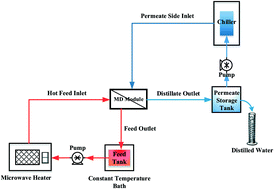Reduction of scaling in microwave induced membrane distillation on a carbon nanotube immobilized membrane
Abstract
Membrane distillation (MD) is an emerging technology that has much potential in desalination and treatment of saline waste. Although MD has shown its ability to treat high salinity waters, membrane fouling is still one of the major issues that limit the long-term stability of MD. In this paper, we report the reduction in scaling during microwave induced membrane distillation (MIMD), where the feed water is heated by microwave irradiation instead of conventional thermal heaters. MD was carried out using a carbon nanotube immobilized membrane using highly concentrated aqueous calcium carbonate, calcium sulfate and barium sulfate solutions, and it was observed that the decline in flux over time was significantly less in MIMD. As compared to conventional heating, the salt deposition on the membrane was 50–79% less during microwave heating. Scanning electron microscopy analysis also showed that the morphologies of the deposited salts from MIMD were different from those from conventional MD. The decrease in scale formation was also confirmed by dynamic light scattering studies which showed that microwave heating formed smaller particles than those via conventional heating. The study clearly demonstrated that MIMD not only generated a higher flux, but also had significantly less fouling with the inorganic scalants studied here.



 Please wait while we load your content...
Please wait while we load your content...